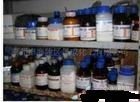


maerbing
第9楼2013/01/08
Nitric acid* is used primarily in the preparation of inorganic sample types.++ It is a very useful component in the destruction of organics but cannot by itself completely decompose organic matrices.
*All reference to HNO3 will mean 69% 'concentrated' nitric acid unless specified otherwise.
++The conventional meaning of inorganic is intended along with the presence of low molecular weight water soluble organic cmpds. and organometallic cmpds. containing relatively small molecular weight organic components.
The following is a summary of some common inorganic dissolutions using nitric acid:
Dilute 10 - 15 % aqueous dilution - Alkaline earth oxides, lanthanide oxides, actinide oxides, Sc2O3, Y2O3, La2O3.
1:1 HNO3 + H2O - V2O5, Mn oxides, CuO, CdO, Hg oxides Tl oxides, Pb oxides, Bi oxides, Cu0, Zn0, Cd0, Hg0, Pb0.
Concentrated (69%) HNO3 - Mn0, Fe0 (hot), Co0, Ag0, Pd0 (hot), Se0, As0, Bi0, Re0.
1:3 HNO3 + HCl - Pt0, Au0, steel, Fe/Ni alloys, Cu alloys, Cr/Ni steel.
1:1:1 HNO3 + HF + H2O - The metal and oxides of Ti, Zr, Hf, Nb, W, Sn, Al, Si, Ge, Sb, Te, As, Se, Mo and numerous alloys and oxide mixtures containing one or more of these elements.
The only major group of elements not listed above are the alkaline earths, of which are all water soluble.
maerbing
第10楼2013/01/08
In the examples listed above nitric acid is acting:
as a strong acid where inorganic oxides are brought into solution...
(1) CaO + 2H3O+ Ca+2 + 3H2O
as an oxidizing agent / acid combo where zero valence inorganic metals and nonmetals are oxidized and brought into solution...
(2) Feo + 3H3O+ + 3HNO3 (conc.) Fe+3 + 3NO2 (brown) + 6H2O
OR
(3) 3Cu0 + 6H3O+ + 2HNO3 (dilute) 2NO (clear) + 3Cu+2 + 10H2O
In addition, nitric acid does not form any insoluble compounds with the metals and non-metals listed. The same cannot be said for sulfuric, hydrochloric, hydrofluoric, phosphoric, or perchloric acids.
Facts About Nitric Acid
The highest valence of nitrogen is +5. This is the valence of nitrogen in nitric acid. All three N-O bonds are sp2 hybrid and the NO3- molecule is planar and symmetrical.
The oxidizing ability of nitric acid decreases (reduction potential decreases) as the concentration decreases. Below 2M, the oxidizing ability is nearly eliminated.
Nitric acid undergoes both one and three electron changes. As illustrated above with reaction (2) the one electron change is observed when concentrated. In comparison, the 3 electron change is observed when dilute in reaction (3). The presence of brown fumes is indicative of reactions going by 1 electron.
(4) H3O+ + HNO3 + e-1 NO2 (brown) + 2H2O : Concentrated
(5) 3H3O+ + HNO3 + 3e-1 NO (clear) + 5H2O : Dilute
Nitrate is generally considered to be a 'poor ligand' in that it's coordination ability is not enough to keep hydrolysis from occurring. This statement may be contradicted in certain inorganic text books.
The most common 'good ligands' used in combination with nitric acid are HCl, HF, and tartaric acid (for Sb). If nitric acid was a better ligand, these additional acids would not be needed.
Concentrations of HNO3 between 65% and 69% are known as 'concentrated'; concentrations greater than 69.2% are known as 'fuming nitric acid'.
100% nitric acid is light and heat sensitive and boils at 84 °C. 'Concentrated' nitric acid boils as an azeotrope (with water at 69.2% HNO3) at a temperature of 121.8 °C. The distilled HNO3 (trace metals grade) should be at the 69.2% concentration level.
Check with your manufacturer of doubly distilled nitric acid to determine if the container in which it is packaged is nitric acid leached prior to use. In the case of Teflon containers, the container material is generally assumed to be pure.
PTFE and PFA Teflon can be heated with concentrated nitric acid, even at high pressures or with combinations such as nitric + HCl, nitric + HF, and nitric + H2O2.
Nitric acid is not a strong enough oxidizing agent by itself to convert organic molecules to CO2 and H2O (completely oxidize).